Korea, surrounded by waters on three sides, features four distinct seasons and more mountains than plains. In these natural conditions, Korean people have developed unique and remarkable food, clothing, housing, and lifestyles. Korea has a unique language and its own writing system, “Hangeul”. Hangeul is a very efficient and easy script to learn and use, and most of all, its promulgation was exactly recorded, which is unique in the world. It can express virtually all the sounds produced by nature and humans. To survive a harsh winter and the intense heat of summer, they developed distinctive clothing made of diverse materials, and various healthy dishes made with the mindset that health comes directly from food. To adapt to the natural environment, they also developed a unique housing setup called hanok.
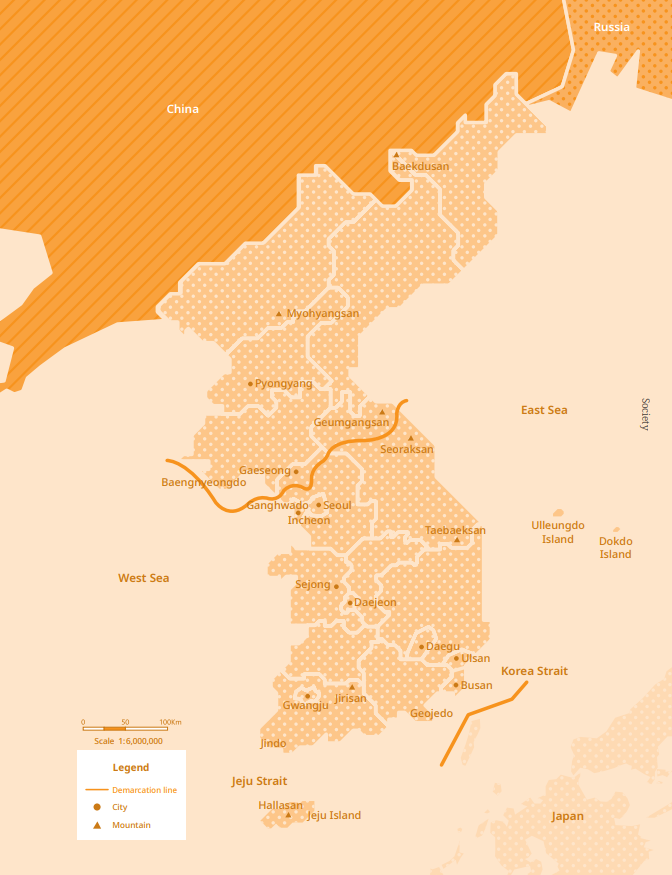
The climate created by the mountainous areas in the east has an impact on people’s lives. The easterly wind’s passage across the mountainous areas is subject to the Foehn effect, creating a warm and dry wind in the western downwind side of the mountain range. People living in the areas to the east of the high mountains experience considerable inconveniences with regard to transportation, as these areas have undergone very little development compared to the area to the west of the high mountains. However, the slow pace of development has brought at least one advantage to local residents: the natural scenery has remained unspoiled, and many people now choose these areas as travel destinations.
The East Sea has a relatively straight, featureless coastline, and the difference between high and low tide is only 30 cm. However, the sea along the coast is generally deeper than 1,000 m. According to the result of a sonar measurement carried out by the Korea Hydrographic and Oceanographic Agency, the deepest part of the East Sea lies in the area north of Ulleungdo Island (2,985 m deep). In contrast, the sea along the West Sea is shallow, which has led to the formation of wide tidal flats.
During the summer holiday season, Haeundae Beach in Busan attracts around 1 million visitors per day. Gyeongpodae Beach in Gangneung and Daecheon Beach on the West Sea are also popular holiday destinations during the summer.
In winter, people enjoy skating and skiing across the country. There are many ski slopes in Gangwon-do. Winter snowfall in the mountainous areas of Gangwon-do sometimes reaches 50–60 cm in a day or two. The average daytime temperature in spring and fall is maintained at 15˚C–18˚C. In these seasons, the sky is clear and the weather is pleasant and agreeable, encouraging many people to engage in outdoor activities or go on a trip.
Recently, the Korean Peninsula has shown signs of transition to a subtropical climate amid the phenomenon of global warming. In summer, the temperature rises above 35˚C. In spring, azaleas and forsythias bloom earlier than in the past. Over the past 4–5 years, many new and extraordinary climate-related records have been reported.
Summer heat waves have become more common, and precipitation patterns are also changing. During the monsoon seasons in the past, rain used to fall nationwide because of the influence of a wet front. Today, torrential downpours, which bring rain to a concentrated area, are often observed. In winter, heavy snow also tends to fall in concentrated regions. Only 10 years ago, it was usual for cold and warm weather to succeed each other on the peninsula every three or four days, but that pattern has almost completely disappeared as well.
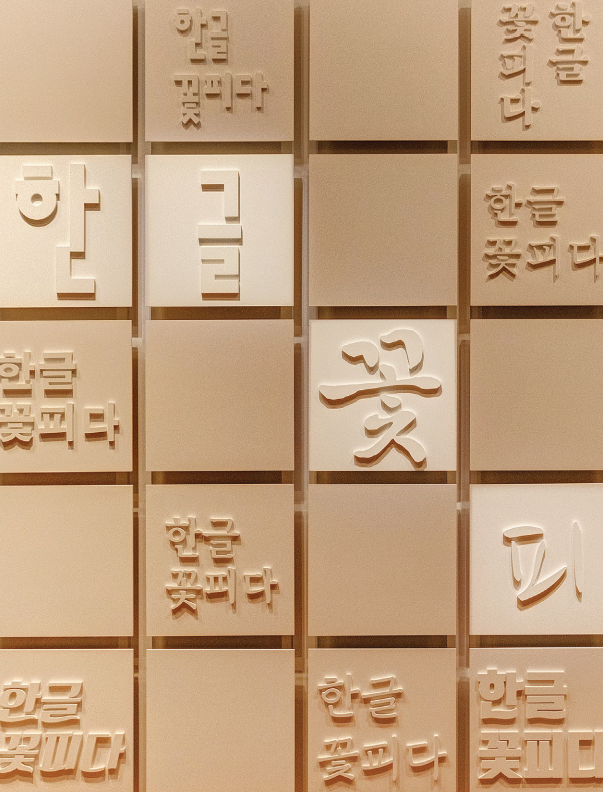 Korea has a unique language and its own writing system, “Hangeul,” which was invented by King Sejong (1397–1450) during the Joseon dynasty. Koreans are very proud of this remarkable achievement. Hangeul is a very efficient and easy script to learn and use, and most of all, its promulgation was exactly recorded, which is unique in the world.
Korea has a unique language and its own writing system, “Hangeul,” which was invented by King Sejong (1397–1450) during the Joseon dynasty. Koreans are very proud of this remarkable achievement. Hangeul is a very efficient and easy script to learn and use, and most of all, its promulgation was exactly recorded, which is unique in the world.Hangeul is composed of 14 consonant letters (ㄱ ㄴ ㄷ ㄹ ㅁ ㅂ ㅅ ㅇ ㅈ ㅊ ㅋ ㅌ ㅍ ㅎ) and 10 vowel letters (ㅏ ㅑ ㅓ ㅕ ㅗ ㅛ ㅜ ㅠ ㅡ ㅣ). It can express virtually all the sounds produced by nature and humans. Every year, UNESCO presents the King Sejong Literacy Prize to people who have made a distinguished contribution to the elimination of illiteracy. The inclusion of “King Sejong” in the name of the prize may be said to be a tacit recognition of his greatest accomplishment, the creation of Hangeul, which is easy to learn and use.
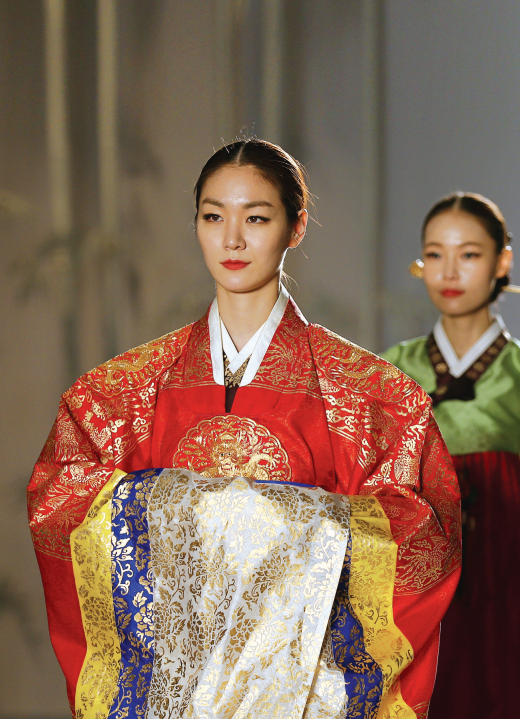 The Korean people learned to use various clothing materials, such as sambe (hemp), mosi (ramie), cotton, and silk, to make a range of clothing that was not only attractive but also provided them with effective protection even during the harshest winters and the hottest summers. They made warm winter clothes using the technique of wadding soft cotton between two pieces of cloth, silk, or cotton fabric, and stitching them in fine lines, and produced cool summer clothes with hemp and ramie. Hanbok is the traditional Korean attire made with these materials, typically featuring graceful lines and forms with a serene aura.
The Korean people learned to use various clothing materials, such as sambe (hemp), mosi (ramie), cotton, and silk, to make a range of clothing that was not only attractive but also provided them with effective protection even during the harshest winters and the hottest summers. They made warm winter clothes using the technique of wadding soft cotton between two pieces of cloth, silk, or cotton fabric, and stitching them in fine lines, and produced cool summer clothes with hemp and ramie. Hanbok is the traditional Korean attire made with these materials, typically featuring graceful lines and forms with a serene aura.Korea’s traditional clothing, hanbok, has maintained its basic traditional features throughout Korea’s 5,000-year history while its styles and forms have evolved in various ways based on the lifestyle, social conditions, and aesthetic taste of the times.
History reveals that in general, Korean people in the past tended to prefer simple, white clothes to fancy ones. That is why they were often referred to as “the white-clad people” among their neighbors who admired them for being peaceful people. Nonetheless, Korea has also had a long tradition of enjoying colorful clothes with complex designs depending on the period and the wearer’s social status.
Today, South Korea is in the global spotlight because of a variety of hanbok designs that reinterpret traditional Korean designs and patterns in a modern artistic sensibility. The music videos of K-pop singers such as BTS and BLACKPINK also contribute to the higher global recognition of hanbok as an attractive costume for its unique style and beauty. In addition, its value is getting admitted popularly thanks to increasing attention even to the ornaments such as gat (Korean traditional hat) that appeared in the Korean drama, Kingdom, which was released for streaming on Netflix, the world’s largest over-the-top (OTT) platform.
Korean people today seem to prefer clothes inspired by modern Western styles to their traditional clothes although some people still insist on wearing the latter on traditional holidays or special family occasions such as weddings. Their love of tradition and yearning for the new sometimes led to the creation of attractive “modernized hanbok.”
Gangnam-gu in Seoul, which is now a household name across the world thanks to “Gangnam Style,” a K-pop song that shook the world in 2012, is a large district where wealthy residential areas sit alongside high-end art facilities and the busiest fashion streets. This special fashion zone attracts numerous fashionminded tourists from around the world with special fashion events by inviting global designers and holding contests for emerging talents to show their designs.
Another fashion district in Seoul that enjoys an international reputation is Dongdaemun-gu, now a hub of the regional fashion industry, which provides creative, affordable fashion items for the young at heart. With its fully developed distribution and sales networks, highly efficient production facilities, and a throng of talented, aspiring designers, this district is now a must-visit attraction in Seoul for foreign tourists.
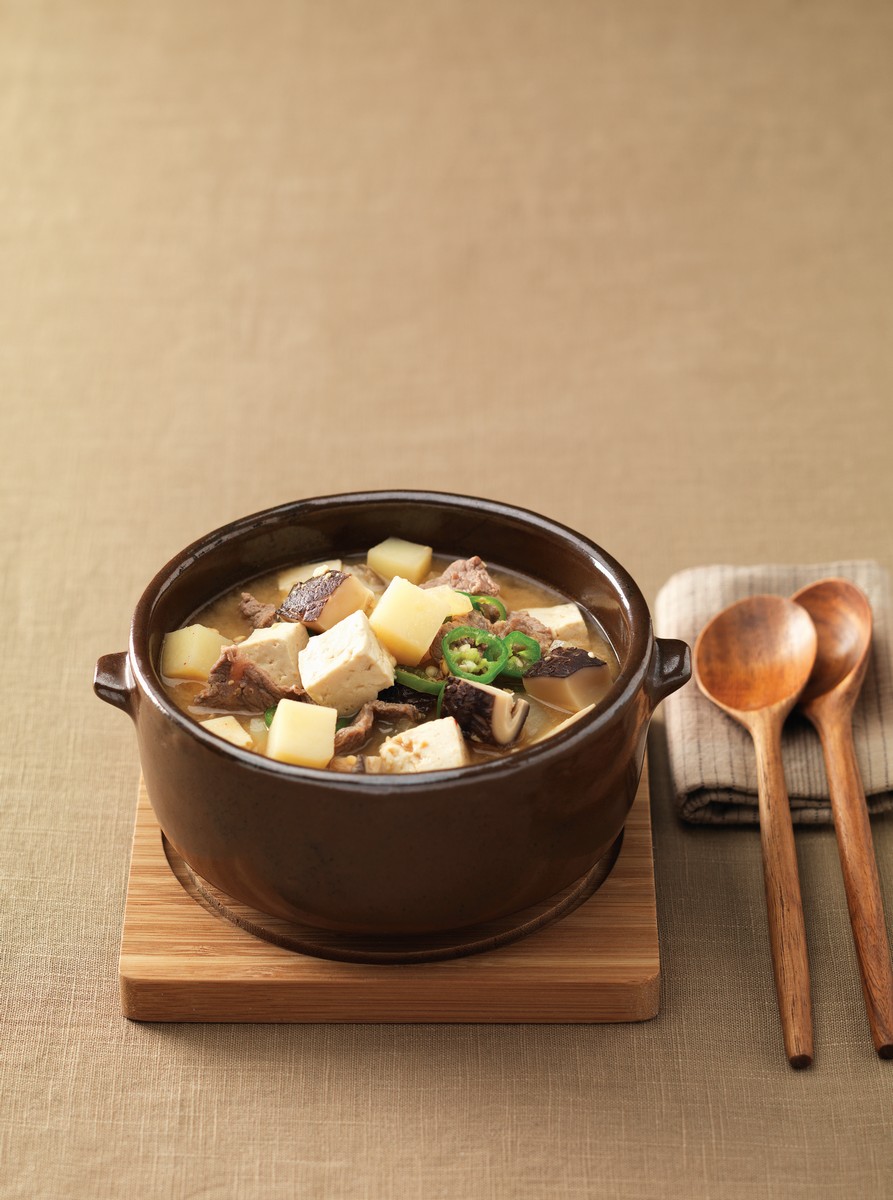 Since ancient times, the Korean people have believed that food and medicine share the same origin and hence perform the same function, following the adage that “food is the best medicine.” They believe that health and illness alike come from the food they consume and how they eat it, and this idea has played a crucial role in the development of traditional Korean medicine whose basic principle is that we should use medicine only after food has failed.
Since ancient times, the Korean people have believed that food and medicine share the same origin and hence perform the same function, following the adage that “food is the best medicine.” They believe that health and illness alike come from the food they consume and how they eat it, and this idea has played a crucial role in the development of traditional Korean medicine whose basic principle is that we should use medicine only after food has failed. Traditional Fermentation of Food
One of the key words to understanding traditional Korean food is fermentation, a metabolic process that helps food to “mature” so that it can be stored for a longer period. The Korean foods that best represent the tradition of fermentation developed in Korea include doenjang (soybean paste), ganjang (soy sauce), gochujang (chili paste), and jeotgal (fermented fish sauce). The fermentation can take anywhere from several months to several years.
Doenjang (Soybean Paste) and Ganjang (Soy Sauce)
Two of the most important items of traditional fermented food in Korea are doenjang and ganjang. To make them, it is necessary to soak soybeans in water and boil them until fully cooked. Then, they must be pounded and formed into brick-shaped lumps, and left to dry and ferment. Then, they are placed in salted water in a large pot along with dried red chili and heated charcoal, which help remove impurities and odors during the fermentation process. The beans thus prepared are then left for about two to three months until they become fully fermented. This product should then be divided into two, solids and liquid, of which the former needs to be brewed for over five more months and the latter for over three months to develop a full flavor and taste. Just like wine, soy sauce tends to have a richer flavor and taste when brewed for a longer period.
Gochujang (Korean Chili Paste)
Gochujang is a traditional Korean condiment made by fermenting a mixture of soybean malt, salt, and chili pepper powder with a blend of powdered rice, barley, flour, and malted barley. Gochujang has long been one of the most important traditional condiments among Korean people, whose palates have evolved toward a preference for hot and spicy foods since they were introduced to chili several hundred years ago. Chili and gochujang are now often regarded as a symbol of the vibrant, energetic disposition of Korean people.
Kimchi
Kimchi, which is gaining a worldwide reputation as one of the representative Korean dishes, has been praised for its anti-carcinogenic properties and nutritional value, as well as numerous variations that create excitingly diverse flavors and tastes. The most common type of kimchi is made by mixing salted white cabbage with kimchi paste made of chili powder, garlic, spring onion, Korean radish ginger, fish sauce, and other ingredients like fresh seafood. Kimchi can be eaten fresh but is normally consumed after fermentation for several days. Some prefer mugeunji, which is fully fermented for over one year.
The ingredients of kimchi vary according to regions and special local produces and traditions. Seoul, for instance, is famous for gungjung kimchi (royal kimchi), bossam kimchi (wrapped kimchi), chonggak kimchi (whole radish kimchi), and kkakdugi (cubed radish kimchi), and Jeolla-do is well known for godeulppaegi kimchi (Korean daisy kimchi) and gat kimchi (leaf mustard kimchi).
Kimchi is getting well-known and well-received around the world. In 2001, the Codex Alimentarius Commission designated Korean kimchi as an international standard instead of Japanese kimuchi, and in 2012 officially published the term of cabbage made in Korea as “kimchi cabbage,” which had previously been referred to as “Chinese cabbage” until then. In 2003, when severe acute respiratory syndrome (SARS) was spreading throughout the world, foreign media reported that the Korean people were safe from SARS because they eat kimchi, which triggered global attention to its efficacy. In 2006, Health Magazine, an American monthly, selected kimchi as one of the world’s five healthiest foods.
Bibimbap
Bibimbap (literally “mixed rice”) is a Korean rice dish served after mixing it with an assortment of fresh and seasonal vegetables, fried egg, minced beef, and other ingredients. It is also served in a sizzling hot stone bowl, which is called dolsotbibimbap (Hot Stone Pot Bibimbap). The dish is closely related to Jeonju, a UNESCO-designated Creative City of Gastronomy, where food festivals such as the Bibimbap Festival are held every autumn, thereby attracting gastronomes from across South Korea and beyond.
Bibimbap, along with kimchi and bulgogi, is considered one of the three representative dishes of Korean cuisine. It is getting more preferred as an airline meal, and more efforts have been put into the development of different bibimbap products to popularize Korean cuisine as a universal global food.
Bulgogi
Bulgogi, which literally means “fire meat,” refers to a traditional Korean dish made by grilling meat after marinating slices of beef or pork in sweet soy sauce mixed with a great variety of condiments mainly made with soy sauce, sugar, and pear juice. Bulgogi is also popular among foreigners, so many South Korean fast-food restaurants serve bulgogi-flavored fast food such as bulgogi hamburgers and bulgogi pizza.
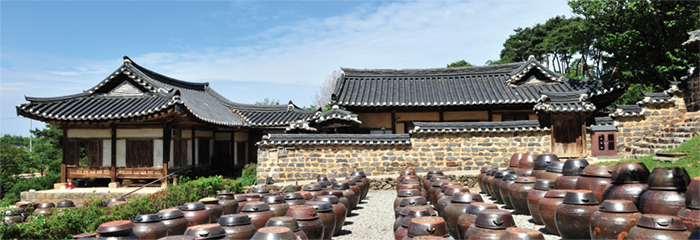
Myeongjae Gotaek, the ancient house of a Confucian scholar of the late Joseon (1392–1910) dynasty, in Nonsan, Chungcheongnam-do
Korean people have developed unique architectural techniques to build housing that is properly adapted to the natural environment, providing dwellers with better protection. One of the distinctive features of the hanok (traditional Korean house) is an underfloor heating system called ondol. Ondol, which literally means “warm stones” and was developed during the prehistoric period, refers to the system of channels running beneath the stone floor of a room through which heat is delivered from the fireplace in the kitchen. It is also designed to effectively draw out the smoke through the under-the-floor passages connected to the chimney.Another architectural feature is the board-floored room called maru located at the center for multiple purposes. The room is usually larger than other rooms and is raised from the ground to allow warm and cold air to freely circulate under it. This creative natural air-conditioning system ensures a cool living environment during the summer. In other words, the traditional Korean house is scientifically designed to incorporate these smart ondol-maru systems in harmony. The roof is typically covered with either giwa (tiles) with different colors or byeotjib (rice straw). While most of the roof tiles are dark gray, some exhibit more vibrant colors as demonstrated, for example, by Cheongwadae, the official residence of the South Korean President, which literally means “Blue House” because it is covered by blue roof tiles.
While traditional Korean houses are generally wooden structures, they can survive as long as other buildings made with other materials if properly taken care of. Presumed to have been built in the early 1200s, the Geungnakjeon Hall of Bongjeongsa Temple in Andong, Gyeongsangbuk-do, is Korea’s oldest extant wooden building. The ideal location for hanok is believed to have hills or mountains at the back of the house to prevent the cold wind and a stream or river in front to ensure easy access to water. Houses built in such a place create a great harmony with the surroundings, attracting more and more admirers at home and abroad.
These days, over 60% of Seoul’s population live in modern apartments, but, interestingly, these tall, multistoried buildings are almost without exception furbished with a heating system inspired by the age-old ondol system. Similarly, newly built detached houses are also reliant on its legacy to heat the floor, although the traditional heat passages are now replaced with under-floor metal pipes with running water heated either by gas or electricity. This traditional Korean heating system has been gaining more popularity not only in South Korea but also in other countries with wide variations in daily temperature.